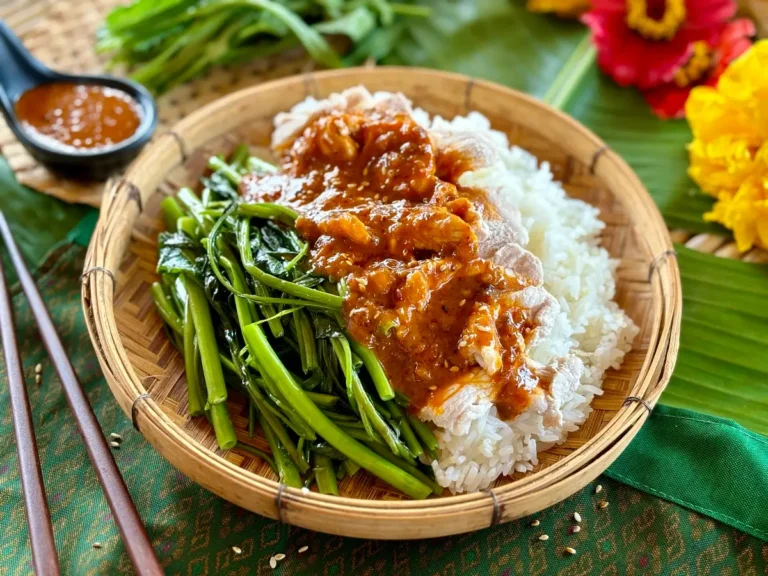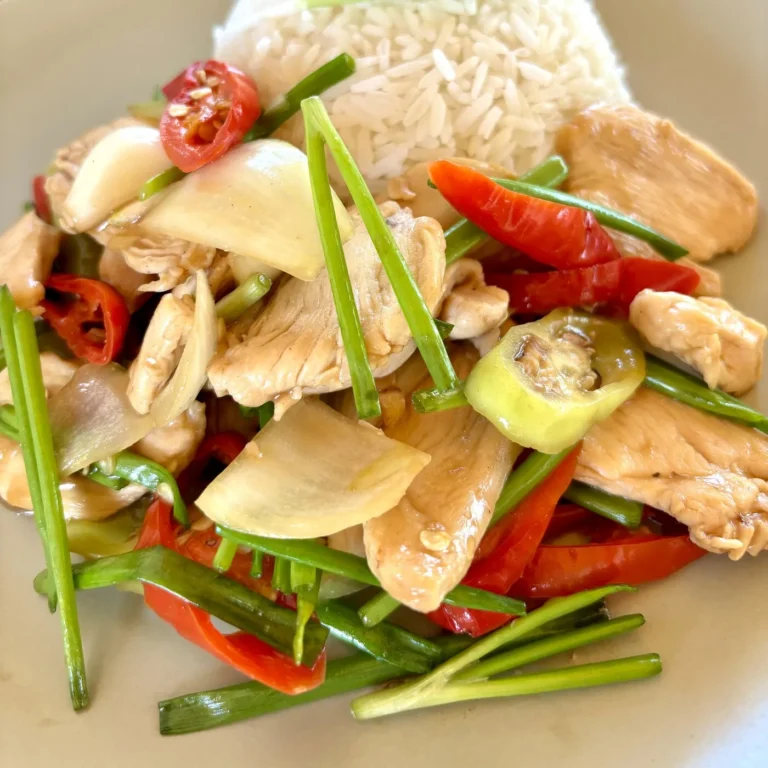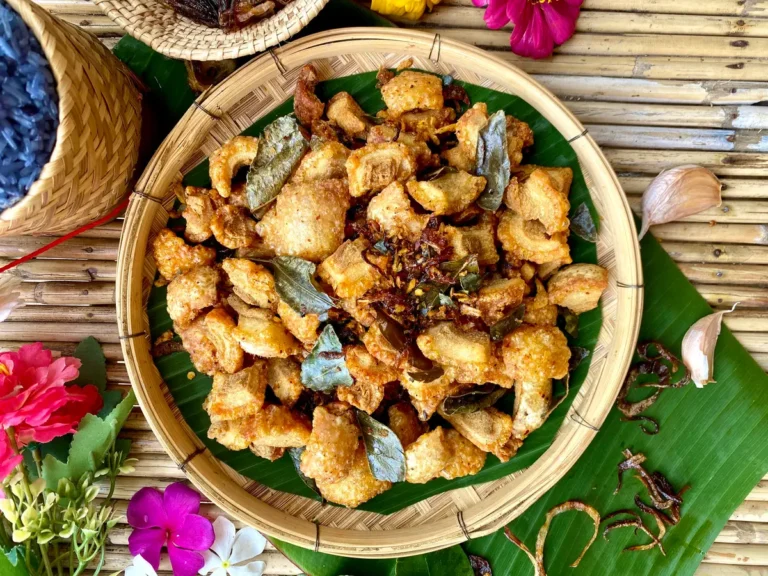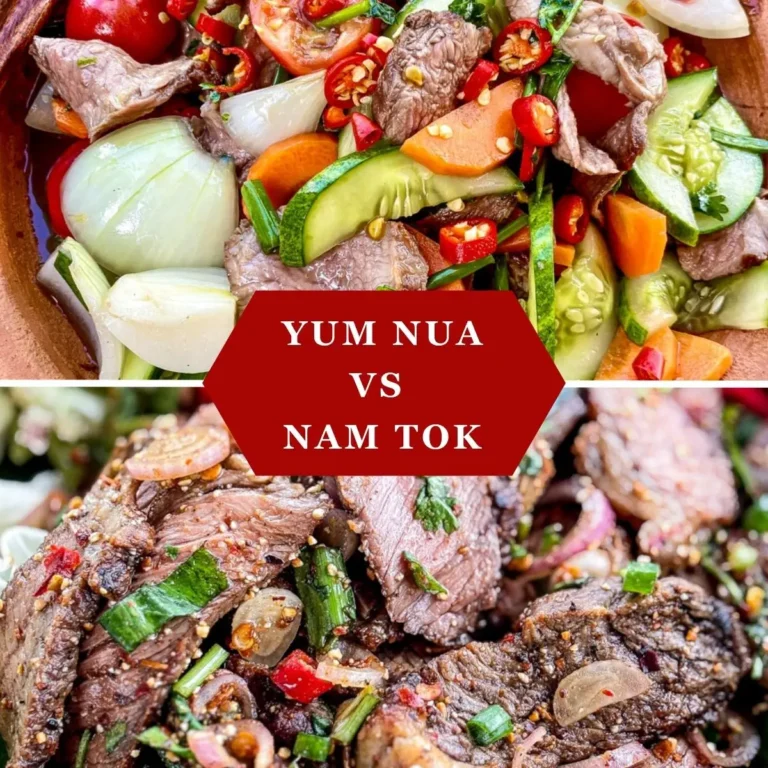Thai Purple Sticky Rice Recipe (2 Ways)
As an Amazon Associate, I earn from qualifying purchases. Read the full disclosure here .
This Thai purple sticky rice recipe is authentic and easy to make. Learn how to make purple rice using two simple methods: one with black rice and water, and the other with butterfly pea flowers. Both methods lead to perfectly steamed glutinous purple rice.

After you’ve made this recipe, you can try turning it into a delicious Thai dessert using one of my Thai purple sticky rice dessert recipes: Thai mango sticky rice, sweet sticky rice with Thai custard, and khao tom mud.
What is purple sticky rice
Purple sticky rice, or purple sweet rice, is a colorful glutinous rice known for its slightly sweet, nutty flavor and sticky texture. It’s often used in Southeast Asian desserts and is traditionally steamed in a bamboo steamer.
In Thai, purple sticky rice is called khao niao muang. Khao niao means sticky rice and muang is purple.
How is purple rice made
You can make purple rice in two ways. One way is by mixing white and black glutinous rice with water, and the other is by mixing butterfly pea flowers with water and lemon.

- Butterfly pea flowers and lemon method: This technique for making purple rice involves cooking dried butterfly pea flowers with lemon juice. The key is the lemon juice, which alters the pH balance, ensuring the rice turns purple. After preparing this mixture, white glutinous rice is soaked in it. Over hours, the rice absorbs the color of the purple water, giving it a deep purple hue.
- Mixing white and black glutinous rice: This method mixes white and black glutinous rice, which causes the black rice to release its natural pigments, infusing the white rice with a purple tint. The result is purple glutinous rice grains.
For perfect purple sticky rice, mix 3 cups of white glutinous rice with 1 cup of black glutinous rice. Too much black rice makes it hard, so keep this ratio for soft and just right Thai purple rice.

Did you know that you can make pandan sticky rice and pandan jasmine rice using fresh pandan leaves?
What is black rice
Black rice, or forbidden rice, is a healthy dark grain that turns purple when cooked. It’s a nutritious grain that’s rich in antioxidants like anthocyanin, tastes nutty, and has a chewy texture. It’s popular in Asian countries like China, India, and Thailand.
Why is it called forbidden rice
The name forbidden rice is a nod to ancient China, where black rice was once reserved exclusively for royalty. The deep, purplish black grains were prized for their health benefits and unique taste.

The black grains were a symbol of status and luxury, forbidding the common people from growing and consuming it. It used to be a rare rice and people believed consuming it was the key to a long and healthy life.
Today, forbidden rice or black sticky rice is no longer forbidden. It’s a staple in Southeast Asian cuisine and has found its way around the world.
Its rich, nutty flavor and slightly chewy texture is perfect for Thai desserts or pairing with savory dishes like moo yang (Thai grilled pork) and Thai beef jerky.
Sticky rice in Thailand
Thai sticky rice, or “khao neow” (khao niao) as we call it, is a cultural symbol. In Northern and Northeastern Thailand, especially in Isan, sticky rice is a daily staple.
Steamed sticky rice is served in handwoven bamboo baskets, ready to be paired with traditional Thai salads like Thai pork larb, spicy som tum Thai, and Thai raw beef salad.

In both Isan and Northern Thailand, colored sticky rice is an important part of festivals and ceremonies. It’s a symbol of community, often offered to monks, and a key element in rituals and celebrations. Thai culture wouldn’t be complete without it.
In Southern Thailand and Bangkok, the locals lean more towards jasmine rice. Many Isan locals are heading towards other parts of Thailand for better work opportunities.
These days, sticky rice is a staple across Thailand, with many Thai restaurants and street food stalls serving up tiny baskets of sticky rice.
White sticky rice is often paired with spicy Thai salads, and Thai sticky purple rice is a staple in desserts.
Ready to lean more about Northeastern Thai culture?
Ingredients
Ingredients can be sourced at Asian grocery stores and Asian markets.
The exact measurements are in the recipe card at the end of this post.
Butterfly pea flower method

- White glutinous rice – Thai glutinous rice, also known as Thai sweet rice, is a type of long-grain rice popular in Asian cooking. Its high amylopectin content gives it a unique, sticky texture when cooked. Its grains are thicker and chewier than the classic jasmine rice. In Thailand, classic sticky rice is usually long-grain, different cultures, like China and Japan, prefer the short-grain variety. Do not try to subtitute for other short-grain rice like risotto and sushi rice, this will not work.
- Butterfly pea flower – Butterfly pea, a blue flower from Southeast Asia, releases a bright blue color when soaked in hot water. This changes to purple when you add lemon juice, which is one of the two methods used in this Thai purple sticky rice recipe. It’s also used in herbal teas and medicine and you can easily find it dried in Asian grocery stores or at Amazon.
- Water – When you boil water with butterfly pea flowers, it pulls out their blue color.
- Lime – The acidic nature of fresh lime juice turns the blue hue from the butterfly pea into a deep purple color.
White and black glutinous rice method
Mixing white and black glutinous rice with water allows the natural purple dye of the black rice to infuse into the white rice, creating that beautiful purple Thai rice.

- White glutinous rice
- Black glutinous rice
- Water
How to make purple sticky rice
First, wash your rice and then choose one of two methods to make purple Thai rice: either using butterfly pea flowers and lemon or mixing white and black glutinous rice. Then, proceed with the steaming process using either a bamboo steamer or a regular steaming pot.
Wash and rinse glutinous rice

1. First, rinse your glutinous rice 2-3 times.
Purple rice method 1: butterfly pea flowers and lemon juice

1. Boil water: Begin by placing a pot of water on the stove. Set the heat to medium.

2. Infuse with pea flowers: Add butterfly pea flowers to the boiling water and keep it there for about 5 minutes. This gives the water a blue hue.

3. Transform with lime juice: After boiling for 5 minutes, turn off the heat. Now, add fresh lime juice to the mix. The water transforms into a lovely purple color. Be mindful not to overdo the lime juice to maintain the perfect pH balance.

4. Make purple glutinous rice: Place white glutinous rice in a large bowl. Using a sieve to catch the butterfly pea flowers, pour the prepared hot purple water over the rice and let soak for 3 hours. After soaking, drain purple water to reveal your purple rice grains and continue with the steaming steps.
Purple rice method 2: mix white and black glutinous rice

1. Combine the rices: Take a large bowl and combine both black and white glutinous rice in it.
2. Submerge in water: Pour water into the bowl until all the rice is submerged. Mix the rice thoroughly using your hands.
3. Soak: Allow the rice to soak for at least 4 hours. If you have the time, letting it soak longer will enhance the texture and flavor.
4. Drain: Once your rice has soaked and absorbed the water, drain out the now-purple water. What you’re left with is purple glutinous rice, ready for steaming.
Steaming method 1: regular steaming pot

1. Prepare water in pot: Add water up to 2 inches high in the bottom part of the steaming pot.
2. Line steamcloth: Place a piece of cheesecloth on the steaming insert to prevent rice grains from falling through. Spread the purple rice evenly on the cheesecloth and wrap the rice completely in it.
3. Boil water: Bring the water to a boil over medium heat.
4. Place over pot: Once the water is boiling, place the steaming insert with the rice over the pot. Cover the pot with a lid.
5. Steam: Steam the rice for about 20–25 minutes. Begin checking for readiness around the 20-minute mark. Occasionally check if the water hasn’t completely evaporated.
6. Fluff and serve: Once cooked, fluff the rice with a fork before serving, or transfer it to a sticky rice basket to keep warm.
Steaming method 2: bamboo steamer

1. Add rice to steamer: Place the purple rice inside the bamboo steamer.
2. Set up steamer: Position the bamboo steamer over a pot with 2 inches of boiling water, ensuring the water doesn’t touch the steamer’s bottom.
3. Steam the rice: Cover the bamboo steamer. Steam the rice for approx 20 minutes, or until it’s tender and sticky.
4. Fluff and serve: Once cooked, fluff your Thai purple rice with a fork before serving, or transfer it to a sticky rice basket to keep warm.
Kitchenware for Thai purple rice
- Sticky rice steamer pot and bamboo basket: This traditional Thai sticky rice steamer delivers perfectly cooked glutinous Thai rice each time. The bamboo basket over a thin aluminum pot ensures each grain gets cooked evenly. A regular steamer can be used to steam the sweet purple sticky rice if you don’t have a traditional sticky rice steaming set.
- Fine mesh strainer: If you want to rinse your glutinous rise to remove excess starch.
- Sticky rice basket: The best tool for storing cooked sticky rice, keeps warm and prevents it from drying out.
- Cheesecloth: A cheesecloth is needed to wrap the uncooked soaked sticky rice in the steamer. This ensures even cooking and prevents the glutinous rice grains from falling through the steamer openings.
Tips for steaming sticky rice
How to make sticky rice without a steamer: Don’t have a traditional steamer? No worries. Grab a large pot and add a few inches of water. Just enough to create steam, but not too much. Bring it a boil, take a colander, and place it over the pot. Make sure it’s not dipped in the water. Tuck your soaked rice in a kitchen cloth and place it on the colander, then close with a lid. Steam for 20-30 minutes.
Watch the water level while steaming: Too little water, and your bamboo steamer might burn. Too much water results in mushy sticky rice. Keep the water level just right – it should steam your rice without ever touching it. When it looks like your water is running low, add some more boiling water.
Spread rice equally: Before steaming, spread the soaked purple rice in an even layer. This ensures each rice grains gets equally puffed up.
Soak your rice: Soak your glutinous rice for at least 3 hours, or better overnight.
What to do with purple sticky rice
If you have a bamboo basket, transfer your steamed purple sticky rice to it to keep it warm. If you don’t have one, simply serve your sticky rice in a small bowl.
In Thailand, sweet purple rice is commonly used for making desserts like purple mango sticky rice. You can also enjoy it as a side dish alongside other Thai food like Thai beef jerky and nam tok moo.
Thai sticky rice is eaten with your hands. Roll it into small, bite-sized balls and pair it with an array of fresh vegetables and Thai dishes like pla pao (steamed fish) and moo ping (grilled pork skewers).

How to store sticky rice
Store your Thai sticky purple rice right to maintain its texture and flavor:
- In a bamboo sticky rice basket at room temperature: I always keep my steamed sticky rice in a bamboo basket at room temperature. You can wrap that in a plastic bag to keep it waarm for longer. Use it within a day or two.
- Refrigerated in a food container: If you need to store for longer, place it in a food container in your fridge for up to 3 days. The rice will harden, but you can simply reheat it. Before serving, lightly sprinkle the rice with water and microwave it for about a minute.
- Store it in a small plastic bag: At Thai street food markets, the sticky rice is portion into small plastic bags. This helps in mainting the right moisture level in the rice and is perfect for on-the-go snacking.
- Using a damp cloth: For short term-storage, if you don’t have a bamboo basket, wrap the rice in a damp cloth and place it in an airtight container.
Leftover pea flowers? Use them to make butterflea pea flower tea!
How to reheat sticky purple rice
- Steam it: Steaming leftover sticky rice restores its textures, preventing it from turning hard or soggy. Use a bamboo steamer or any other steamer and steam for 10–15 minutes, or until soft.
- Reheat sticky rice without a steaming pot: Heat a small amount of water in a pot and place a steaming rack above the water level. Place the rice on the steam rack and cover the pot with a lid. Cook for 10–15 minutes over low heat, or until the rice is soft.
- Microwave: If your sticky rice is in a clump, break it apart. Sprinkle it with a bit of water. Lay a damp paper towel over the bowl of rice. Place in your microwave and reheat for about one minute. The exact time may vary, depending on the amount of rice and the power of your microwave. Check the rice’s temperature and moisture, if it’s not warm enough, microwave for longer.
Thai purple sticky rice facts
Good fortune: In Thailand, sticky purple rice is often preserved for special occasions and ceremonies. Some believe that serving purple Thai sticky rice brings good fortune and prosperity, making it perfect for weddings.
Nutrition: The elder people of Isan say that sticky rice is the secret to strength. Farmers and laborers in Isan consume it to fuel their days in the rice fields. Sticky rice is packed with carbohydrates, the body’s primary source of energy. It’s a healthy source of carbs and great for a boost of natural energy.
Frequently asked questions
Is purple sticky rice healthy?
Purple sticky rice is healthy as it’s rich in antioxidants, thanks to its natural purple pigment, which comes from anthocyanins. Additionally, it’s a good source of fiber, essential nutrients, and carbs.
Why is my Thai rice blue?
If you soaked your Thai rice with butterfly pea flowers and added lime or lemon, it might turn blue due to the natural colorant from the pea flowers. The blue color is completely natural.
Where to buy glutinous rice?
Glutinous rice, also known as sweet rice and sticky rice, can be found in Asian grocery stores, larger supermarkets, and online marketplaces. It’s commonly available in both white and black rice varieties.
What does purple rice taste like?
Purple rice’s flavor is comparable to the flavor of white sticky rice. It has a slightly denser chew than its white counterpart and a nuttier flavor with a gentle sweetness and chewy texture.
Is glutinous rice the same as sweet rice?
Yes, glutinous rice is the same as sweet rice. It’s a staple in many Asian cuisines, used in desserts and savory meals.
Authentic Thai rice recipes
- Chicken pineapple fried rice
- Toasted rice powder (Thai khao khua)
- Khao taen recipe (Thai crispy rice cakes)
- Thai congee (rice porridge)
- Khao tom (Thai rice soup)
- Khao jee (sticky rice with egg)
Loved reading this Thai purple sticky rice recipe? Please make my day by dropping a star rating and/or a comment below! Follow me on social media: Facebook, Instagram, and Pinterest.
Thai Purple Sticky Rice Recipe (2 Ways)

Ingredients
For the butterfly pea method
- 5 cups water
- 1/3 cup dried butterfly pea flowers
- 1 tablespoon lime juice, see notes
- 1 1/2 cups uncooked glutinous rice
For the black glutinous rice method
- 1 1/2 cups uncooked white glutinous rice
- 1/2 cup uncooked black glutinous rice
Instructions
Wash and rinse glutinous rice
- First, rinse your glutinous rice 2–3 times.
Purple rice method 1: butterfly pea flowers and lemon juice
- Begin by placing a pot of water on the stove. Set the heat to medium.
- Add butterfly pea flowers to the boiling water and keep it there for about 5 minutes. This gives the water a blue hue.
- After boiling, turn off the heat. Now, add fresh lime juice to the mix. The water transforms into a lovely purple color. Be mindful not to overdo the lime juice to maintain the perfect pH balance.
- Place white glutinous rice in a large bowl. Using a sieve to catch the butterfly pea flowers, pour the prepared hot purple water over the rice and let soak for 3 hours. After soaking, drain purple water to reveal your purple rice grains and continue with the steaming steps.
Purple rice method 2: mix white and black glutinous rice
- Take a large bowl and combine both black and white glutinous rice in it.
- Pour water water into the bowl until all the rice is submerged. Mix the rice thoroughly using your hands.
- Allow the rice to soak for at least 4 hours. If you have the time, letting it soak longer will enhance the texture and flavor.
- Once your rice has soaked and absorbed the water, drain out the now-purple water. What you’re left with is purple glutinous rice, ready for steaming.
Steaming method 1: regular steaming pot
- Add water up to 2 inches high in the bottom part of the steaming pot.
- Place a piece of cheesecloth on the steaming insert to prevent rice grains from falling through. Spread the purple rice evenly on the cheesecloth and wrap the rice completely in it.
- Bring the water to a boil over medium heat.
- Once the water is boiling, place the steaming insert with the rice over the pot. Cover the pot with a lid.
- Steam the rice for about 20–25 minutes. Begin checking for readiness around the 20-minute mark. Occasionally check if the water hasn’t completely evaporated.
- Once cooked, fluff the rice with a fork before serving, or transfer it to a sticky rice basket to keep warm.
Steaming method 2: bamboo steamer
- Place the purple rice inside the bamboo steamer.
- Position the bamboo steamer over a pot with 2 inches of boiling water, ensuring the water doesn’t touch the steamer’s bottom.
- Cover the bamboo steamer. Steam the rice for approx 20 minutes, or until it’s tender and sticky.
- Once cooked, fluff the rice with a fork before serving, or transfer it to a sticky rice basket to keep warm.
Notes
- Use the nutrition card in this recipe as a guideline.
- Lime juice: Add lime juice to turn the blue water into purple. Add more or less lime juice on sight.
- No steamer? Use the colander method: Boil a few inches of water in a pot. Set a colander on top (not touching the water) with drained rice spread evenly. Cover with a cloth and lid. Steam 20–30 minutes until cooked.
- While steaming, monitor the water level closely. If it evaporates fully, the steamer can burn. Ensure water doesn't touch the rice to avoid mushiness.
- To make perfect purple sticky rice mixing black and white glutinous rice, use a ratio of 3 parts white glutinous rice to 1 part black glutinous rice. Be careful with the black rice – it's firmer, and using too much can make your rice hard. Stick to this ratio for soft, perfectly textured purple rice every time.







Great and very informative recipe for purple sticky rice! I paired it with ripe mangoes and also prepared some grilled pork.